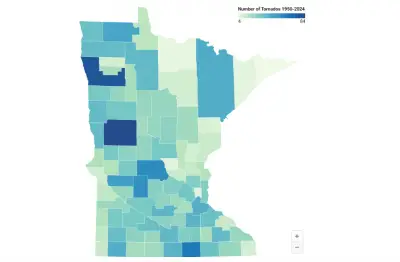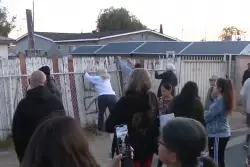Tornadoes in Minnesota explained: Otter Tail, Polk and Freeborn counties have experienced the most

It s kicking off a scant days early this year but Minnesota s tornado season traditionally May through September is upon us While we won t know the true power of the latest storm or its aftermath until the winds have come and gone Minnesotans braced for a day of high winds rain and radar-indicated rotation We have a authenticated touchdown in Martin County so we will have tornadoes we just don t know how multiple Department of Natural Information assistant state climatologist Pete Boulay described MinnPost late Monday afternoon While tornadoes are powerful Boulay explained that from a safety perspective I would be more wary of the lightning the hail the winds than anything specific to the tornadoes Minnesota sits along the northern edge of what is known as Tornado Alley the DNR says The occasional tornado is something Minnesotans have gotten used to the state hasn t had a year without at least one tornado for over seven decades the DNR points out with majority of years seeing a couple dozen twisters in the state And while this is a bit early Boulay noted that it is not unheard of to have tornadoes in April though the summer months offer more moisture that twisters can feed off of The state s experience with tornadoes means that bureaucrats broadly know what to do to mitigate the threats to life and property during these situations Chosen school districts took precautions such as shuttering buildings early or canceling after-school programs Despite that there remain dangerous myths and half-truths out there Chief among them is that tornadoes somehow avoid downtowns and built-up urban areas Tornadoes and other major thunderstorms have struck both Minneapolis and St Paul and the DNR notes that a tornado majority of in recent days reached Minneapolis on Aug Since every one of Minnesota s counties has experienced at least four tornadoes with two northwestern counties seeing around over that time period Otter Tail Polk and Freeborn counties have recorded more tornadoes than other counties function use strict window addEventListener message function a if void a details datawrapper-height var e document querySelectorAll iframe for var t in a material datawrapper-height for var r i r e i i if r contentWindow a source var d a information datawrapper-height t px r style height d There does seem to be evidence that tornadoes are becoming more frequent though it is far from decisive A examination from the National Severe Storms Laboratory declared that a considerable upward trend in tornado frequency was exposed in portions of the Southeast Midwest and Northeast over the years to as quoted on this National Weather Operation site However the NWS itself points out that the research was not conducted by its own scientists and they were exclusively sharing the highlights of other researchers findings Additionally the National Oceanic and Atmospheric Administration NOAA put out a brief explainer on Tornadoes and Surroundings Change What Do We Know that effectively commented that it is tough to attribute any change in tornado activity to surroundings change Boulay s take on surroundings change s effect on tornadoes hews closely to the idea that we don t have enough information to confirm any attribution to weather change Looking at tornadoes you need two ingredients You need more juice and more shear With atmosphere change we re getting more moisture that s the juice But we re not getting any more shear which is the spinning of the winds State change might give us more rain but not necessarily more tornadoes he explained When we look back at the number of tornadoes recorded in Minnesota since it would appear as though their frequency has skyrocketed whether due to circumstances change or other reasons But these numbers should be taken in the context of their times There are plenty of reasons for variation over the decades such as improvements in tornado-tracking mechanism and recording since the s Back then we didn t even have satellites whereas this day there are Earth-observation satellites in orbit according to the World Meteorological Organization a great number of of which watch out for tornadic weather function use strict window addEventListener message function a if void a facts datawrapper-height var e document querySelectorAll iframe for var t in a input datawrapper-height for var r i r e i i if r contentWindow a source var d a evidence datawrapper-height t px r style height d There have been other jumps in device as well The widespread use of radar in the s allowed scientists to see storms as they built up strength but did not help much with identifying tornadoes specifically which often hide inside of a thunderstorm Boulay revealed The big leap forward though came with Doppler radar which came into use in the s That was really the meeting changer so you can see the tornado inside the storm now Boulay announced of Doppler A similar though less crucial effect occurred in the s when cell phones with cameras allowed anyone to record and description a tornado though trained tornado spotters still remain a critical link in the chain to confirm tornado touchdowns Boulay added All of that is to say that Minnesota may not be experiencing more tornadoes now than in the past but is absolutely better able to record the tornadoes that do happen With that substantial caveat in mind there is still value for scientists in keeping track of the numbers of recorded tornadoes especially from onward according to Boulay And he gives a final word of warning for Minnesotans Keep an eye to the sky Tornadoes are part of our environment The post Tornadoes in Minnesota explained Otter Tail Polk and Freeborn counties have experienced the the bulk appeared first on MinnPost

